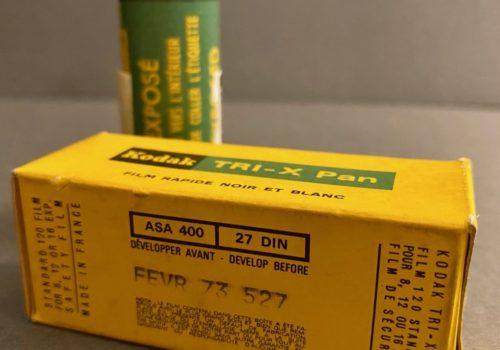In this chapter, Jacques Revon explores the use of an ecological alternative developer made with raw, old and artisanal cider at 7°.
“Film photography is initially authentic because the negative remains, even if one day it is scanned and therefore becomes digital at the risk, as we know, of being later manipulated.” – JR
Sheet 9. Making an alternative developer in a quantity of 1 liter ready to use, with raw, old and artisanal cider at 7°.
400 cc to 700 cc of developer are generally necessary to develop a 24X36 format film of 36 views or a 120/6X6 film in a tank.
- Dissolve the following products well in 400 ccl or 700 cc of cider in order, one after the other. Dilution temperature from 20° to 22°.
60 grams of sodium carbonate
9 grams of vitamin C.
6 grams of iodized salt.
Finally, add 2 drops of photo-Flo to promote development.
- Pre-wet your film or foil for five minutes in temperate distilled water, then proceed to development.
- Development tests.
Test 1 Expired Kodak Tri-x 400 ASA 6X6 Film (1973) used at 200 ASA. Temperature 26.5° duration 35 min.
Test 2 Film 24X36 Rollei 100 ISO Temperature 25° development time 25 minutes. Good results.
Test 3 Film 24X36 HP5 Ilford 400 ISO Temperature 25° development time 20 minutes. Good results.
- Fixing.
Here, three minutes in Hypam Ilford 1+4 at 20° then to save water, wash the film with the method recommended by Jost j Marchesi in the book “Ilford Procédé Négatif” published in 1980 by Editions Jean Spinatsch in Geneva, provided that you have fixed your film with this fixer.
– 1 Empty the tank well to wash and rinse the spiral which contains your film.
– 2 Fill the tank with water then slowly tip it over 5 times by rotating, let the water work from top to bottom.
– 3 Empty the tank again, then fill it and this time, slowly tip it over 10 times, always in the same way.
– 4 Empty the tank again then fill it a third time and tip it 20 times.
– 5 If you want your film to be kept as long as possible, then carry out the previous operation twice more.
Finally, soak your film in a wetting agent for 30 seconds to, I remind you, help reduce the surface tension of the water on the surface of the emulsion and thus promote regular runoff of the water which adheres on the surface of the film or, soak your film in demineralized water for one minute. Then, hang your film by weighting it, to let it dry in the open air.
- Comments.
In the first test the development lasted too long, I then had to weaken the film with the Howard Farmer method, that is to say with a solution of potassium ferricyanide.
Important: To carry out this operation and handle your film in a bowl, it is particularly advisable to wear gloves and protective glasses.
Prepare a solution A: Water = 500 cc and add 50 g of sodium thiosulfate (hyposulfite) here 50 cc of Hypam fixative.
Prepare solution B: Water = 100 cc and add 10 g of Potassium Ferricyanide.
To use, mix well 100 cc of preparation A with 5 cc of preparation B.
The weakening mixture only lasts for around sixty minutes, so the mixture should only be carried out a few moments before starting the operation.
Warning: stop the weakening action even before obtaining what you want as a result, in fact the weakening continues a little during the following wash. Effective washing must be carried out for a few minutes with fresh water. If you wish, you can keep your preparations A and B for a few weeks in properly labeled, airtight and tightly stoppered bottles, and in a closed, dark place out of the reach of children.
Tips: When dissolving the products, proceed slowly so as not to create too much foam in reaction, especially with the first product to be dissolved, namely sodium carbonate.
In photography, it is also strongly recommended to take your used or unused products to the recycling center.
- Contribution of colors during an alternative development with cider, the negative of which was subsequently weakened.
Following this development with cider, I noticed that my film was a little too sensible (over-developed), I then decided to carry out a sag with the so-called “Farmer” method (Howard Farmer, 1884) this method allows, with Potassium Ferricyanide, to weaken the density and contrast of a negative, you will also find the formula on the internet.
During the weakening of this film, the emulsion as a whole became orange .
A little later, once the treatment was finished and as I am used to, I decided to scan the 6X6 negatives in strips of three, to visualize all of my results. (on an Epson V750 pro Scan).
So, I proceeded in two stages: I first carried out a first scan of the strips, by programming my main parameter settings with a choice of setting: 16-bit gray monochrome negative film, then in view of the color orange obtained after weakening my film, I carried out a second series of Scans, this time choosing the 48-bit Color negative film setting.
The results appeared very different between the two settings, as you will see in the photographs.
Indeed, by programming the Scan on 48-bit color negative film and then on detailed settings, we can play with the B V R color curves and thus directly obtain fairly original color modifications, without going through a subsequent post operation. production, which allows you to create and immediately obtain colored effects during the Scan according to your observations and your own tastes.
Jacques Revon
Journaliste honoraire, auteur, photographe.
https://fr.wikipedia.org/wiki/Jacques_Revon
















